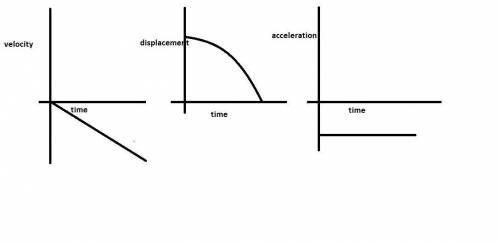
Abrick is released with no initial speed from the roof of a building and strikes the ground in 2.50 s, encountering no appreciable air drag. (a) how tall, in meters, is the building? (b) how fast is the brick moving just before it reaches the ground? (c) sketch graphs of this falling brickâs acceleration, velocity, and vertical position as functions of time.

Answers: 1
Another question on Physics

Physics, 22.06.2019 04:30
The image shows the positions of a car on a roller coaster track. arrange the cars in order based on their gravitational potential energy. begin with the lowest potential energy and end with the highest.
Answers: 1

Physics, 22.06.2019 05:00
In a stagnant pool of water, a crayfish may spend much of its time lying with one side of its carapace near the surface of the water. in this position, it will move the walking legs on that side in a rhythmic back-and-forth motion. explain the likely function of this behavior.
Answers: 1

Physics, 22.06.2019 08:00
Tafari worked one summer on a ship that set weather buoys in the ocean. he watched how one of the buoys moved in the water. describe which parts of the wave would cause the buoy to bob up and down. which wave property determined how fast the buoys bobbed in the water? he observed that when the wind blew harder, the ocean waves were larger, and the buoys moved away from the ship. what effect, if any, did the waves have on how far the buoys moved? explain your answer.
Answers: 3

Physics, 22.06.2019 22:00
The inside surface of a cylindrical-shaped cave of inner diameter 1.0 m is continuously covered with a very thin layer of water. the cave is very long and it is open on both ends. the water on the cave surface is at a constant temperature of 15.5 °c. the cave is constantly exposed to wind such that 15.5 °c air flows through the cave at 4.5 m/s. the kinematic viscosity of the air is 14.66 x 10-6 m2/s and the molecular diffusion coefficient of water vapor in the air is 0.239 x 10-4 m2/s. because the cave diameter is so large, the flow of wind down the length of the cave, in the x direction, can be treated like it is external flow and the cave surface can be approximated as flat where appropriate. calculate the x value, in a) the transition to turbulent flow occurs at rex meters, where the air flow transitions from laminar to turbulent along the inside surface of the cave b) calculate the x value, in meters, where the bulk steady state concentration of water vapor in the air flowing in the cave is 10% of the saturation concentration. assume the air at the surface of the water layer is 100% saturated with water vapor. assume the wind entering the cave contained no moisture before it entered the cave. take into account the transition from laminar to turbulent flow when solving part b
Answers: 1
You know the right answer?
Abrick is released with no initial speed from the roof of a building and strikes the ground in 2.50...
Questions



History, 24.07.2019 14:00

Biology, 24.07.2019 14:00


History, 24.07.2019 14:00

Biology, 24.07.2019 14:00

Biology, 24.07.2019 14:00




Social Studies, 24.07.2019 14:00

Biology, 24.07.2019 14:00

Biology, 24.07.2019 14:00



Biology, 24.07.2019 14:00


Biology, 24.07.2019 14:00










